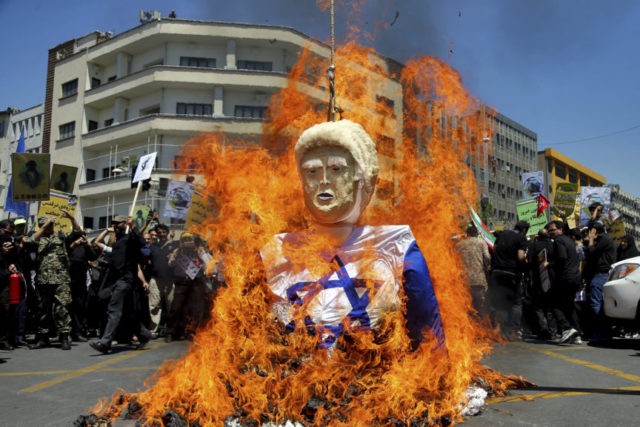GAZA CITY, Gaza Strip (AP) — Palestinians burned tires and Israeli troops fired heavy volleys of tear gas Friday to push back large Gaza crowds from the area of the fence separating the blockaded territory from Israel.
It was the latest in a series of protests against the decade-long blockade of Gaza by Israel and Egypt. Friday’s march also coincided with the annual “Jerusalem Day,” instituted by Iran to protest against Israeli rule of the holy city. Israel and Iran have been arch enemies since Tehran’s 1979 Islamic Revolution.
In the capitals of Iran and Iraq, thousands of Shiite Muslims marched in Jerusalem Day protests, some chanting “Death to Israel” or burning Israeli flags and effigies of President Donald Trump.
Friday’s Gaza protest was accompanied by concerns about renewed bloodshed. At least 115 Palestinian protesters, the vast majority unarmed, have been killed and close to 3,800 have been wounded by Israeli army fire since the marches began in late March.
After Muslim noon prayers Friday, thousands of Gaza residents began streaming toward five protest tent camps that had been erected more than two months ago, each several hundred meters (yards) from Gaza’s perimeter fence. From there, smaller groups walked closer to the fence.
In a camp east of Gaza City, activists burned tires, releasing thick black smoke into the air. Israeli troops fired heavy tear gas volleys, including from drones, sending protesters running for cover.
One man with a bullhorn shouted, “America is the biggest evil.”
The mass protests have been aimed at a border blockade imposed by Israel and Egypt in 2007, after the Islamic militant group Hamas overran the territory. The marchers have also pressed demands for a “right of return” for the descendants of Palestinian refugees to ancestral homes in what is now Israel.
More than 700,000 Palestinians were expelled or fled in the 1948 Mideast war over Israel’s creation. Two-thirds of Gaza’s 2 million residents are descendants of refugees.
Protester Fadi Saleh said the frequent marches have helped revive sympathies in the Arab world for the Palestinians, but that more could be done. “We need real Arab support and solidarity with our cause,” said Saleh, a student of Arabic literature who wore a medical mask against the tear gas.
In previous border protests, activists have also sent kites with incendiary materials attached toward Israel with the aim of setting fields there on fire. Others have thrown fire bombs or tried to damage the fence. Israeli soldiers, including snipers perched behind earthen berms, have fired live bullets and tear gas.
Israel’s use of potentially lethal force against the protesters has drawn international criticism. Rights groups have said Israel’s open-fire rules are unlawful.
Israel has accused Hamas of trying to carry out attacks and damage the fence under the guise of the protests. Hamas leaders have threatened possible mass border breaches, raising concerns in Israel that communities near Gaza might be at risk.
The protests have largely been organized by Hamas and to some extent by the smaller Islamic Jihad militant group. Both have received political and financial backing from Iran, but also pursue their own agendas. Growing despair in Gaza over blockade-linked hardships, including daily hours-long power cuts and rising poverty, have driven turnout.
Israel and Egypt argue that they must maintain the blockade to contain Hamas and other militant groups, which have built weapons arsenals over the years, including short-range rockets. Israel and Hamas have fought three cross-border wars since 2008.
The Jerusalem Day protests are being held each year on the last Friday of the Muslim fasting month of Ramadan. The day is known in Arabic as “Al Quds Day,” a reference to the city’s historic Arabic name.
Israel captured east Jerusalem in the 1967 Mideast war and annexed it to its capital, a move not recognized by most of the international community. Israel’s current government has said it will not accept a partition of the city as part of a peace deal with the Palestinians.
The eastern sector houses major shrines revered by Muslims, Christians and Jews. The Al-Aqsa Mosque compound in east Jerusalem, the third holiest site in Islam, is built on the spot where tradition says the Prophet Muhammad ascended to heaven. The compound sits on the ruins of biblical temples and is revered by Jews as the holiest site of their religion.
In Iran’s capital of Tehran, thousands joined a Jerusalem Day march on Friday, chanting “Death to Israel” and burning a Trump effigy.
In Iraq, thousands of Iran-backed Shiite militiamen in uniform marched through the streets of the capital of Baghdad on Friday, setting an Israeli flag on fire and carrying posters of the late Iranian leader Ayatollah Ruhollah Khomeini and Supreme Ayatollah Ali Khamenei.
___
Associated Press writer Amir Vahdat in Tehran contributed reporting.

COMMENTS
Please let us know if you're having issues with commenting.